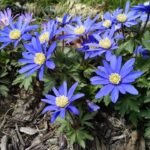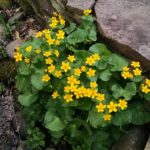 One of the earliest blooming flowers in the Catskills region is the Marsh Marigold. It’s not really a marigold but it does grow in wet places that are at least seasonally flooded. This habitat preference is reflected in its scientific name, Caltha palustris. The name Caltha comes from a Greek word meaning ‘yellow-flower’, and palustris meaning swamp or marsh. It can form dense stands in sunny wet meadows and fields here in the Catskills.
One of the earliest blooming flowers in the Catskills region is the Marsh Marigold. It’s not really a marigold but it does grow in wet places that are at least seasonally flooded. This habitat preference is reflected in its scientific name, Caltha palustris. The name Caltha comes from a Greek word meaning ‘yellow-flower’, and palustris meaning swamp or marsh. It can form dense stands in sunny wet meadows and fields here in the Catskills.
It is called ‘Marigold’ because of its golden-yellow flowers, but it is really an offshoot of the Buttercup family, not a marigold. You can tell that it’s related to the buttercup because it shares a similar flower structure with all members of the buttercup family. A typical flower in this family has a ring of many pollen-bearing stamens around the female parts of the flower, as in this Wind Anemone, another member of the Buttercup family. The female parts clustered together in the center are at least five in number. Caltha flowers have no true petals, however, unlike most buttercup family members, but the 5 to 9 bud covers known as sepals look like petals and serve the same function. Check out my post to better understand the different parts of a flower.
Caltha palustris grows throughout the northern Hemisphere, and there are subspecies in the Himalaya Mountains that have purple or white flowers. The sister species of our Marsh Marigold make up the species group (i.e. genus) Caltha. Caltha is a fascinating genus. There are several species found in wet places throughout temperate (not tropical) regions of South America. Most intriguing perhaps are the species specialized to grow in extreme alpine habitats, such as gravelly wet meadows watered by melting snow or glaciers. The mountain ranges of New Zealand, the Andes, the Himalaya, the North American Rockies and Cascade mountain ranges all have endemic (their own unique) species of Caltha. There is also a species of Caltha, C. natans (natans in Latin means ‘swimming’) which is a true aquatic plant, sometimes found growing on mud but often floating free.
 In the Catskills, the Marsh Marigold can be used to good effect in the water garden. The other species in Caltha are not generally available commercially, but are sought for and grown by rock garden or alpine house gardeners and aquatic gardeners through specialty nurseries.
In the Catskills, the Marsh Marigold can be used to good effect in the water garden. The other species in Caltha are not generally available commercially, but are sought for and grown by rock garden or alpine house gardeners and aquatic gardeners through specialty nurseries.




Hello, How can you tell the difference between marsh marigold and lesser celandine (aka Fig Buttercup)? Thank you.
Hi Alexandra,
Here in the Catskills, Fig Celandine is not a common plant, though it has been reported from the Finger lakes area and the lower Hudson Valley. Fig Celandine is overall a more petite plant, generally reaching only six inches in height. It looks more mat-like in habit. The leaves are smaller (under 2″ in width), heart-shaped and not very glossy. The flowers have true petals and sepals (bud covers). Marsh Marigold is much more robust, generally starting at six inches in height and easily reaching 18 inches tall. The leaves are thick and glossy, large (2-4″ wide), kidney-shaped; and the flowers have no true petals, only bud covers that look like petals.